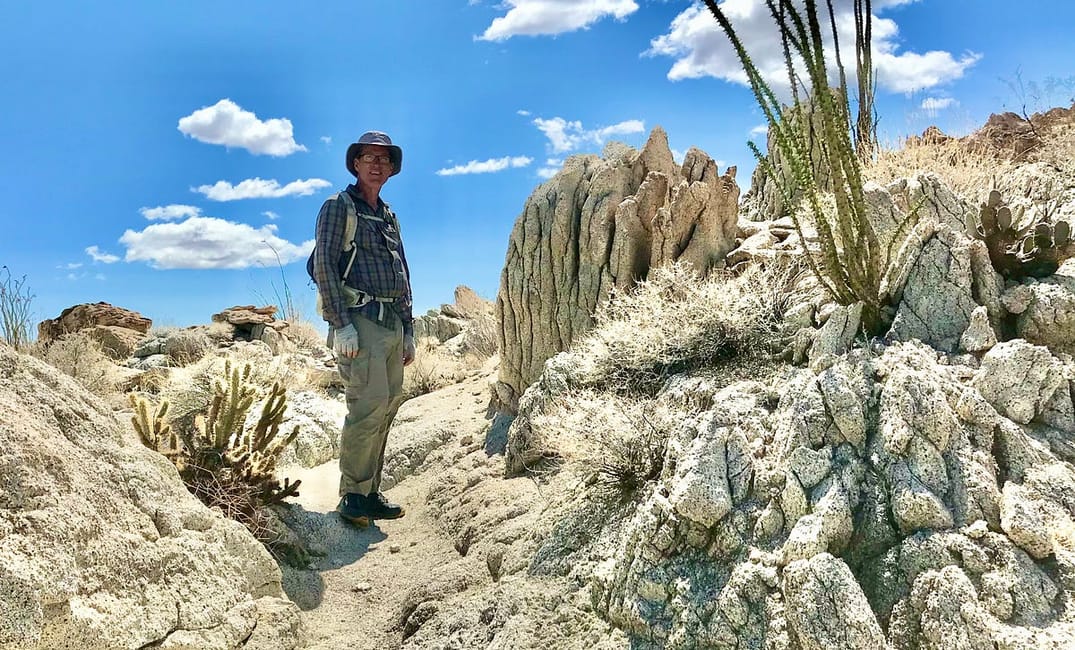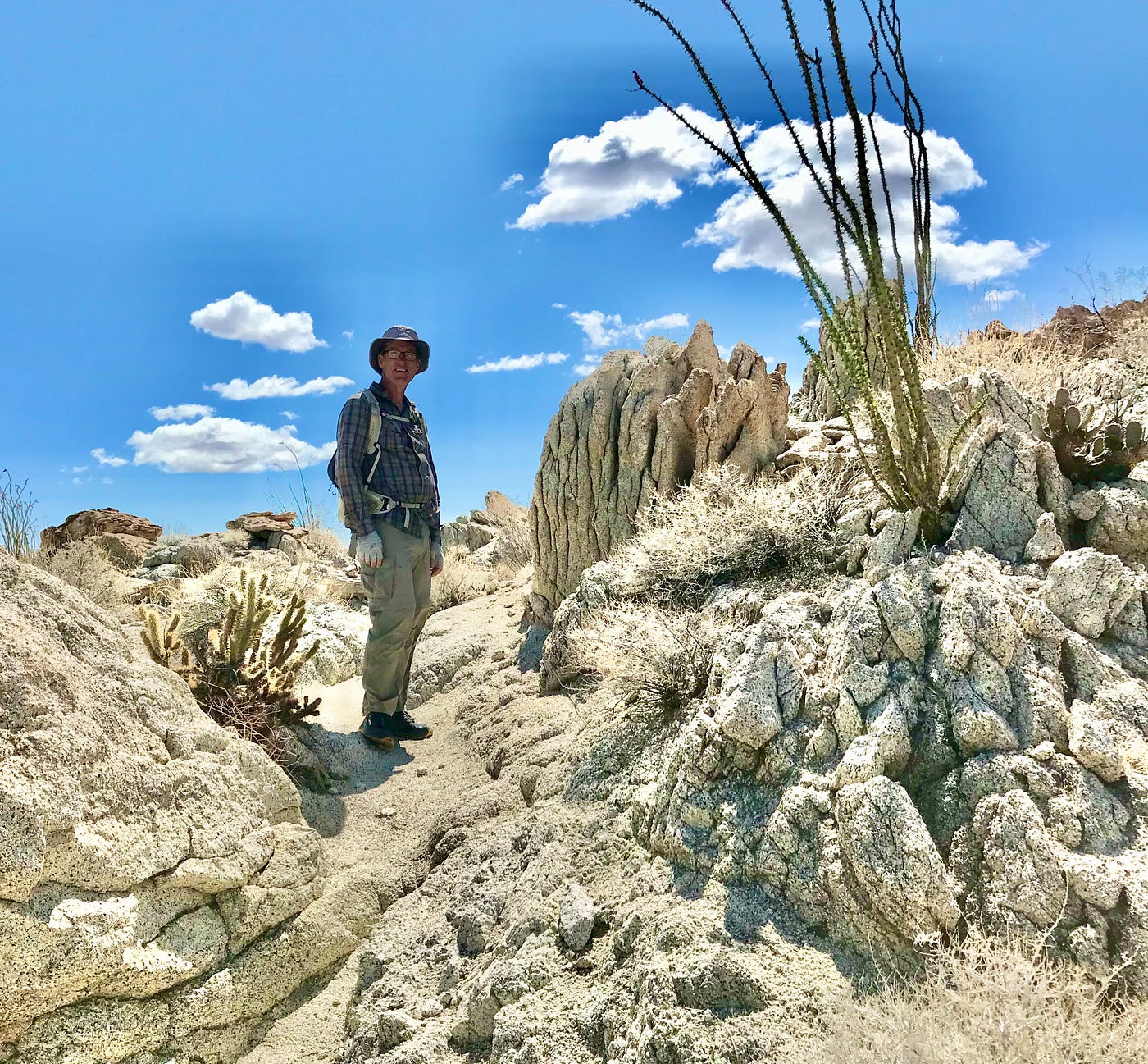
Some years ago, I arrived in Anza-Borrego Desert a month beyond the vernal equinox with the mercury dabbling in the low 100s. I stood with a guide, suddenly roused from lethargy, on the ledge of Font’s Point above the aptly named Borrego Badlands. The scene at our feet was stock still, wasted after untold years of torture. Its poker-faced pattern of shrunken mud repeated across into forever, or probably just Mexico.
It was hard to remain languid confronted with this stretch of the earth in the wake of its lost battle with time. I had hired a guide because I was on assignment for a travel magazine. I needed to penetrate hide-bound terrain expeditiously in a 4WD. With his sun-bleached hair and ruddy-bronze skin, Ted looked as if he should have been out catching a wave. But his affection was for this dry undulation of desert. He acquired his flush, not at the coast, but in this ancient beach of southeastern California, Anza-Borrego Desert State Park.

The more we gazed at the Badlands the more they came alive. Shadows mocked and deepened the wound of land. Colors shifted out of the baked mudpie — dazzling ripples in muted gray, smoke, mold-green, brown, russet. What struck me about the spectacle was that it could be any decade or century; nothing marked time, save the radiocarbon memory of the ocean and lush grasslands the area knew before its dénouement. In the arc of its lifetime were camels, giant turtles, saber-tooth cats, and part of the Grand Canyon. Ted pointed to the red silt conveyed there along the now re-routed Colorado River.
The scene was in startling contrast to the previous hikes we had taken, fording a creek in Coyote Canyon, bushwhacking through thickets of invasive tamarisk (salt cedar), passing barrel and cholla cactus, blooming ocotillo, then on to Catarina Springs. Where there’s water there’s life — we slid through willow, admiring indigo bush, sage, mesquite, dyeweed, cat’s claw, and more.
I left Ted alone from Bow Willow Creek, I attempted to hike Mountain Palm Springs but the heat stymied me. I rested long in the beauty and isolation of the Pygmy Grove, soaking my extremities like the stand of Washingtonia filifera, not knowing that in my distant future I’d meet the palms again on a five-star trip with Desert Survivors led by Paul Harris and Carol Clark.

Diverse as that long-ago visit was, it could not compare with what Paul and Carol showed our group of ten hardy hikers over the weekend of March 18–20, 2022. I arrived on a Wednesday at Bow Willow Campground. I pitched my tent on a hill with a panorama of a sweeping cactus garden and dark hills, empty of visible civilization. Over the next two nights, the moon crushed the horizon, waxing to its opal fullness as the sun crossed the equator splitting light and dark equally for a day, a magical harmonic convergence. It was the perfect home until Saturday evening.

Early Friday morning, our group assembled and got acquainted as Carol and Paul prepared us for the day’s itinerary. I was impressed with their prior knowledge of the terrain and how much prep they had done, including safety precautions. We split into two groups of five piling into the high-clearance 4WD vehicles required to get to the trailhead. I went with Ari, Steve, Jessica, and Dan. For the first of many times, conversation turned to jumping cactus. To the uninitiated, which I was painfully not, it sounds like an urban myth. Those fuzzy golf-sized ovals, detached from their parent, will on the slightest provocation jump a foot to attack. The one that assaulted me years ago even made a U-turn to penetrate my calf, through long pants.
We rolled on the paved S2 until a sandy wash that led to an otherworldly landscape called Arroyo Tapiado Canyon. Most vegetation had skipped town. The prominent features, dark holes in the baked mud walls, were like empty eye sockets, eerie invitations to the curious and daring, which we were. This astonishing landform, new to me, harbored mud tunnels, also called caves, but the tunnel felt more fitting.
Arroyo Tapiado is Spanish for walled wash. These buxom mounds are honey-combed with tunnels (ending in the “eye sockets”), feeding into caves and vice-versa in varying degrees of slant and with varying degrees of clearance. Carol had already assured us that she has some claustrophobia (me too!) so we wouldn’t be getting into any of the really tight tubes. However, we would need headlamps for some of the dark passages where only our disembodied voices united us. We bowed and shimmied sideways quite a bit through narrows, marveling at the labyrinthine network of natural forces. I found myself longing for greenery to break up the monotonous buff color.
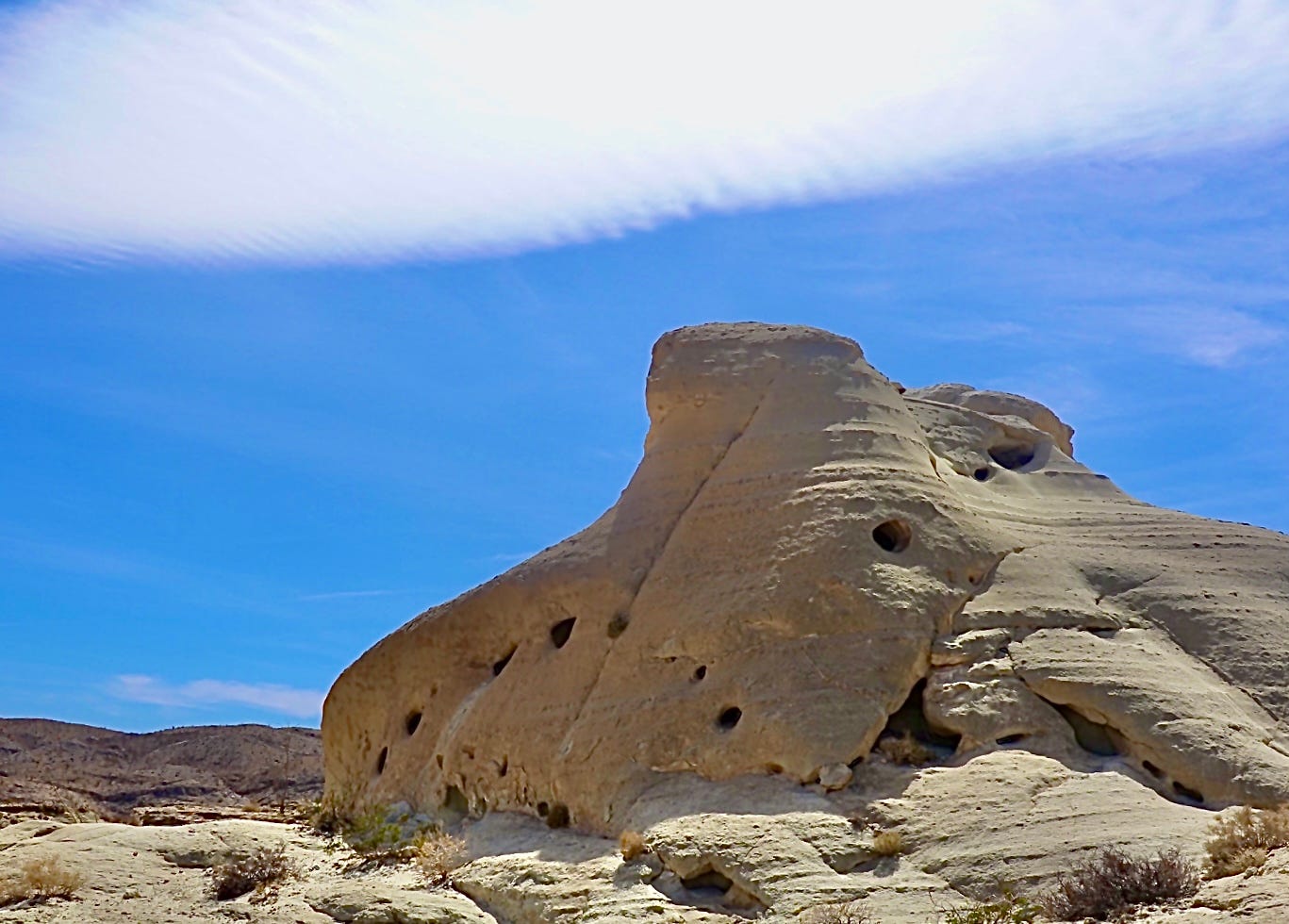
We passed slits in the mud walls that only a small dog could fit through but one fearless member of our group, Brian, collapsed himself like Gumby and disappeared into the black hole. I held my breath until he poked his smiling head out again. After that nothing, Brian did amaze me. (Turns out he is part mountain goat too). The caves are not well known but our guides had maps and a trusty GPS to get us to the best and most stable of them. Carol and Paul had meticulously scoped and researched the safe ones — some are dangerous (there have been accidents) and we avoided those.
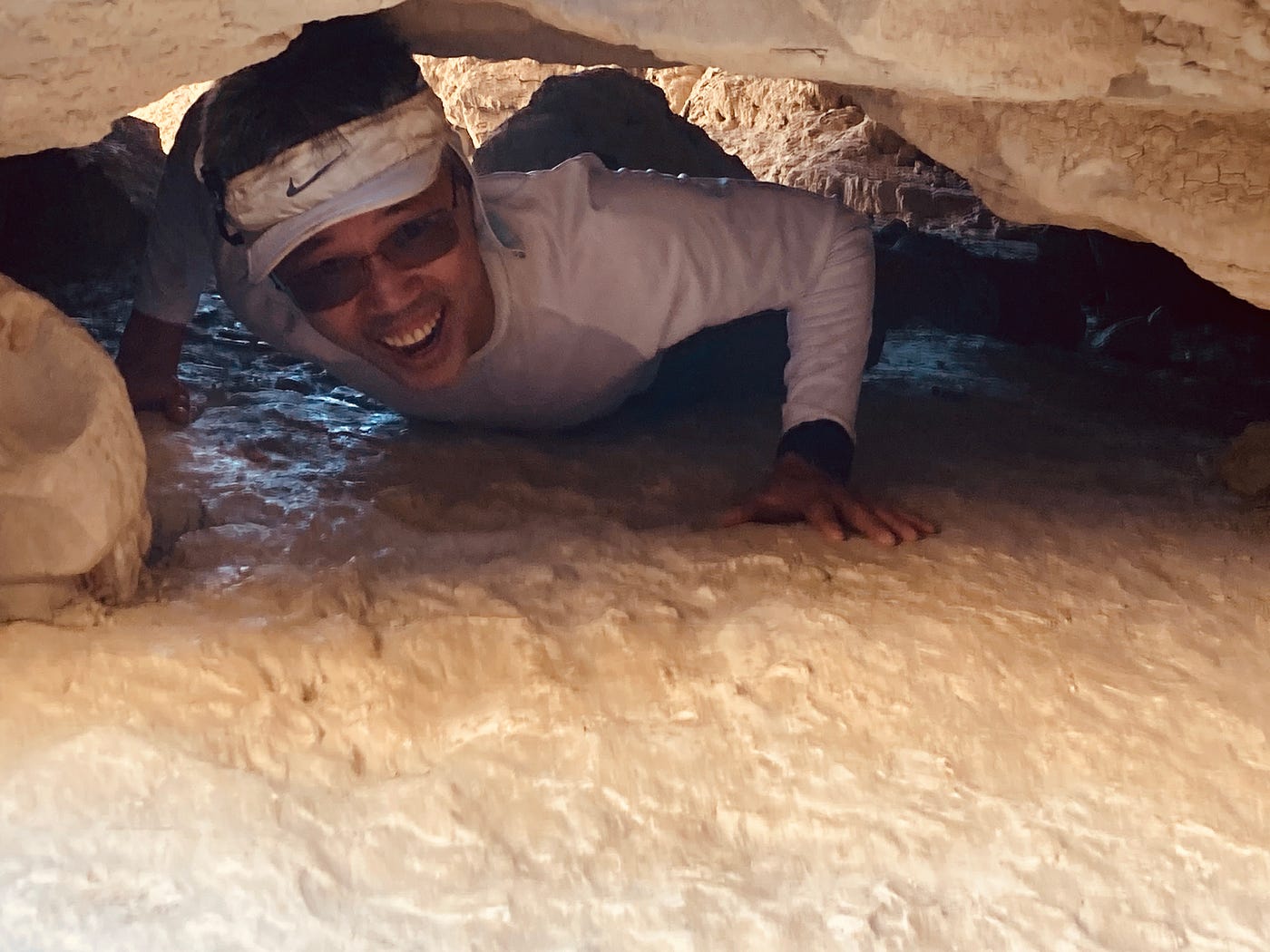
How do you bake a mud hill and pock it with caves? Apparently, you need a thousand or more years and the infrequent heavy rains that erode and cut channels into a type of mud that, thanks to the arid clime, bakes to the cohesiveness of concrete. (Like what you get if you forget to leaven your bread or pizza dough.) From the outside, they have a molded clay pottery look. Inside them, we spent a lot of time arching, ducking overhangs, and playing twister. We did not clock a lot of distance but we were engrossed in this brand of “spelunking” for several hours, totally fascinated with the unique formations, finding the cool interiors relief from the warm exterior temperatures.
Toward late afternoon, our guides had no problem getting group consensus for us to head to the Agua Caliente Springs not far from camp. Geothermally heated waters feed three mineral-rich pools where the leisure soak with Jacuzzi jets dissolved dust and released stiff joints, tired bones, and tight muscles. This collective ritual would be happily repeated every day, thank-you very much.
Early Saturday, following our prep talk and reminder that we needed to carry three liters of water today, we piled into the brawny vehicles. We drove about nine miles down S2 to Road 93, then bumped along washboard dirt to Domelands trailhead. We were greeted by loud reverberating shots bouncing off the stony hills, target practice for gun enthusiasts. We were reminded that firearms regulations for a state park are looser than for a national park. I watched Dan quietly pick up the casings we came across. He also saw fit to collect mindlessly discarded trash even when it was on a near vertical hill. A true blue Desert Survivor.

I was glad for the vaulting sky instead of mud ceilings as we started down the sandy wash. Before long we encountered abundant and luxurious proof of ancient sea beds. Paul and Carol directed our eyes to fossilized seashells, the remains of marine life. There were gastropods, oysters, spirals, chambered nautilus shapes, perfectly formed sand dollars, vestiges petrified and encrusted in cement-hard walls of coarse sand and silt. We were looking at the ancient artistry of the Colorado River and the once tropical inland Sea of Cortez, coupled with deep time, pressure, and the uplift of our famous San Andreas Fault.
Thanks to the violent forces of twisting, crushing, crumpling that sculpted this rugged terrain, we did a lot of climbing up and down with more than 2,000 feet, cumulative elevation. It was worth the effort as we reveled in the magnificence of the randomly assembled mounds, dimpled with caves, and inlaid with aquatic creatures frozen in time.
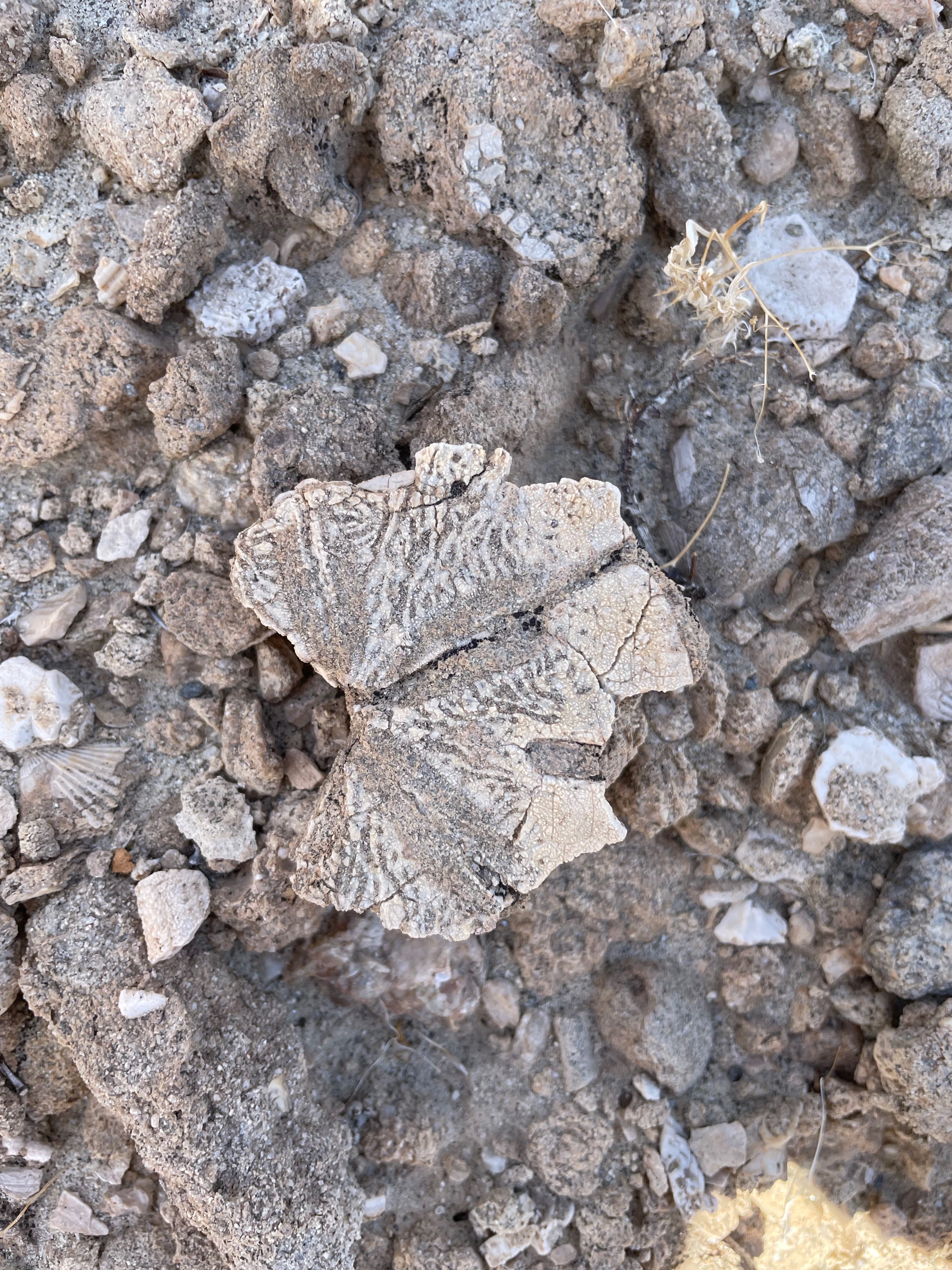

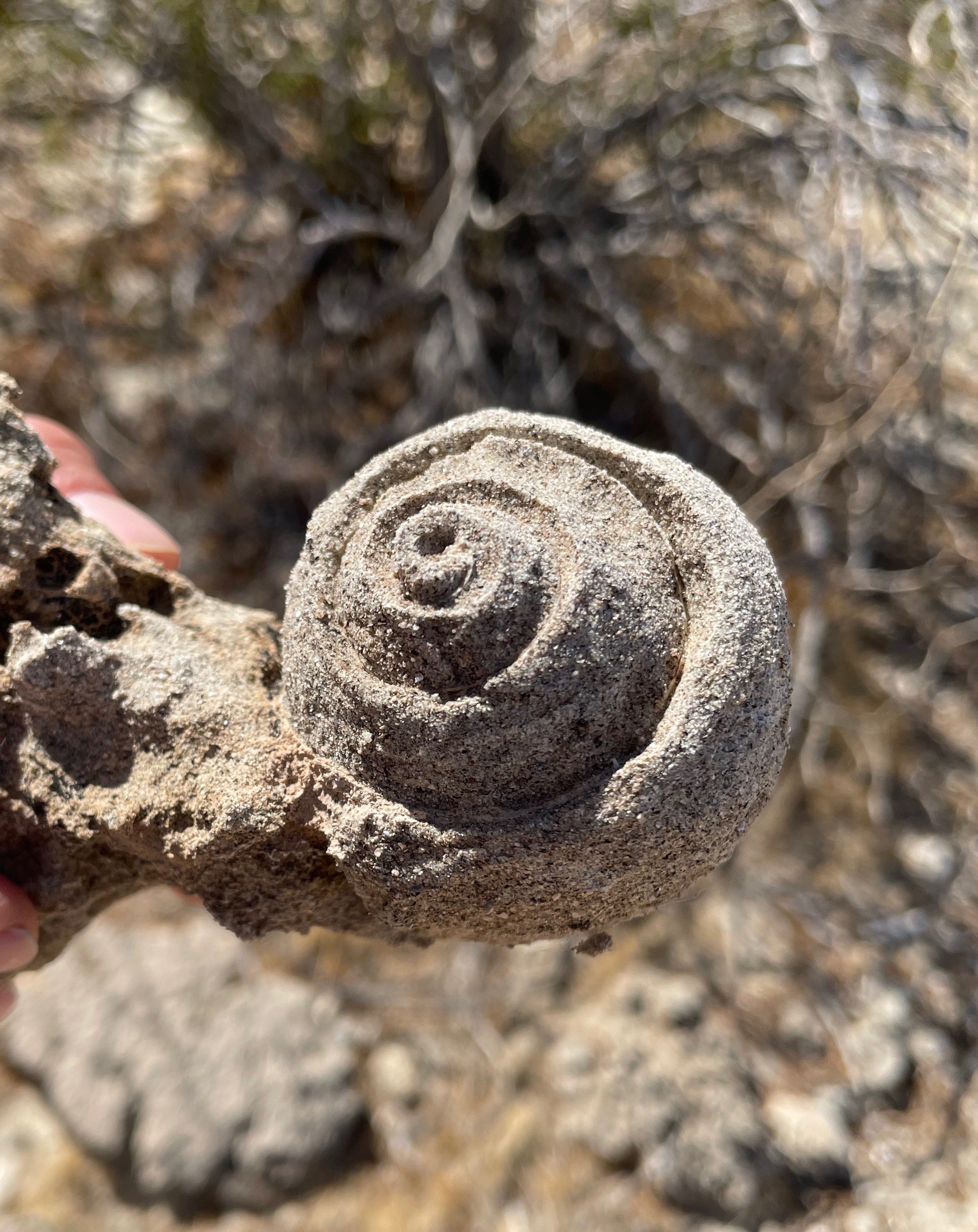
We were ready for lunch at a deep cleft in a canyon wall where we cradled our spent selves against rocks and welcomed the shade and relative isolation. We needed the restorative break. The trickiest part was yet to come. What appeared to me as a box canyon with no exit was a hidden gash in soaring cinnamon-colored rock with shady alleys and very tight squeezes to say the least. We tucked our pelvises and slid sidewise through the narrowest cracks (what me, claustrophobic?). Where the gash widened a bit we had to straddle footholds on either side and gingerly step over deep potholes that would not be fun to fall into. Happy to report none of us did. Also happily, Brian gave some of us a hand, pulling us safely up and over the gaping ditches. I kept looking up from this maze to make sure the sky was still in its place.
The pinnacle and reward of the day came shortly after this test of fortitude. Ahhhh, the wind caves, I can still sense their calm refuge. Atop a long climb, we encountered the cavernous excavations in the rock, like grottos where one expects to find shrines. We scrambled in and out of the natural depressions. Carol and Paul, who knew this route well, leaped into one grotto big enough for two, which I dubbed the Love Seat. Six of us entered a bigger semi-dark and cool one. We fell supine and silent, perhaps all wishing this were home for the night.
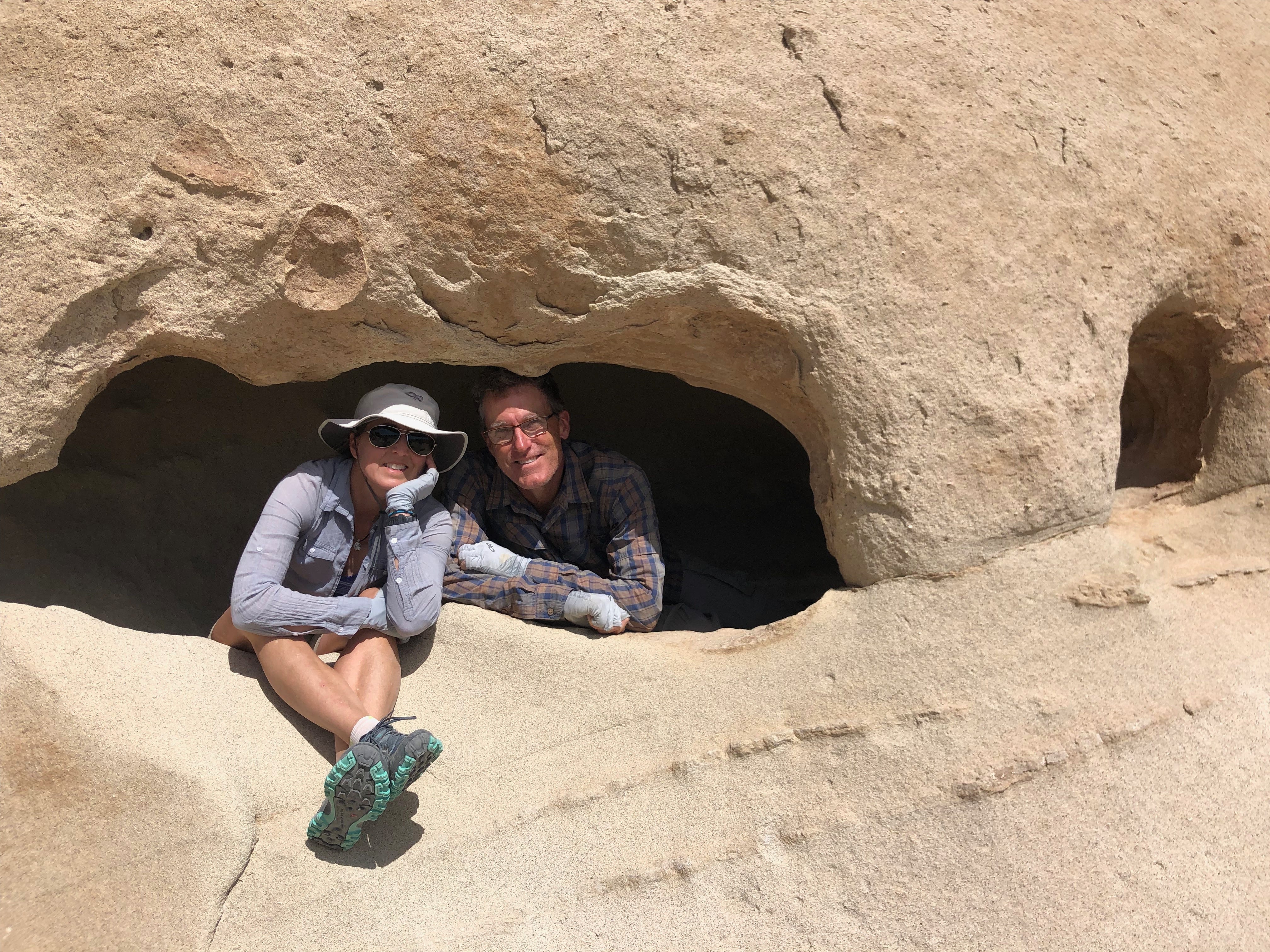
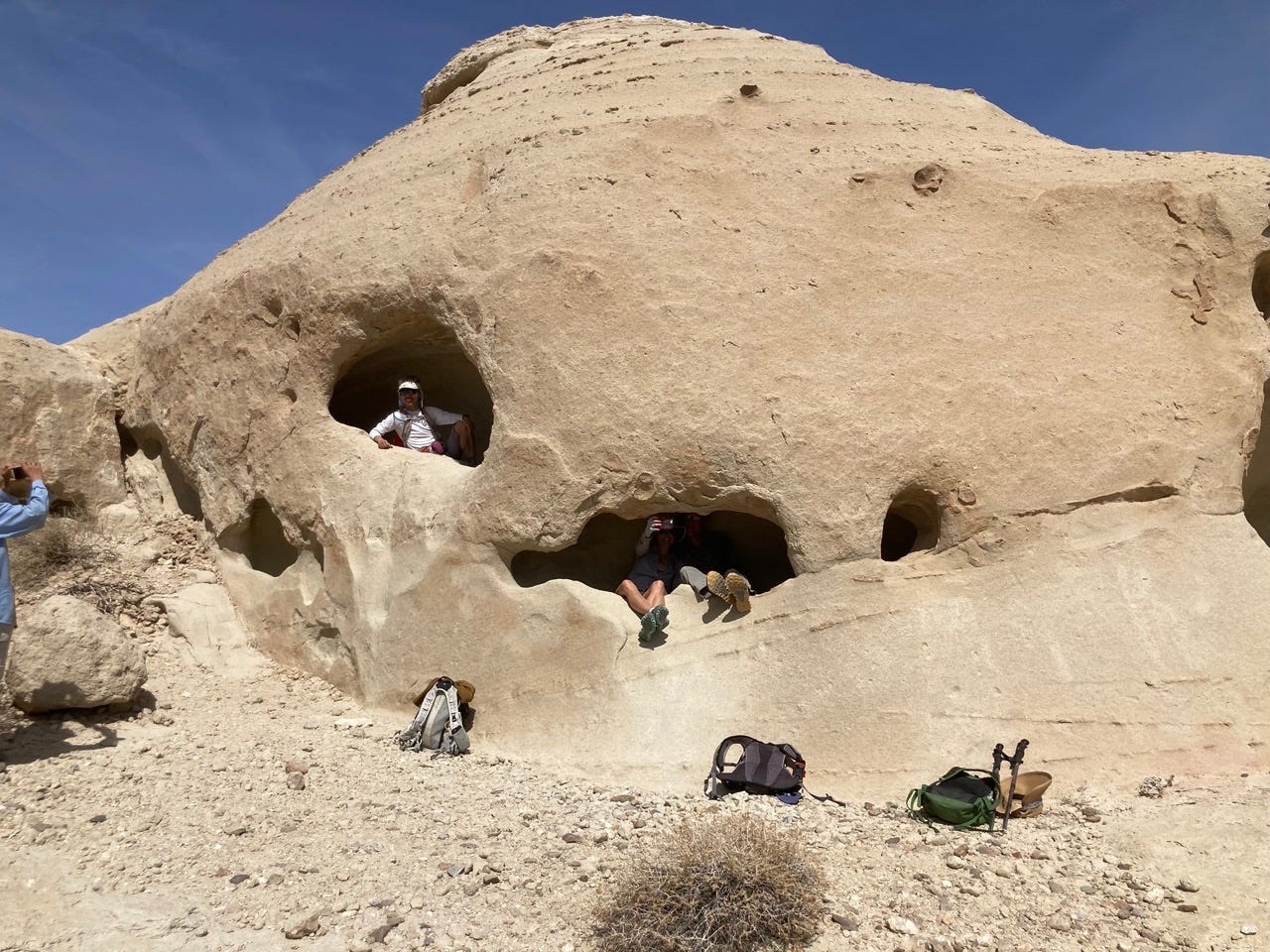
Reluctantly we regrouped and made our way back to the trailhead, stopping to absorb what message there was in a broad view to the Carrizo Badlands.
Saturday night brought the infamous howling desert winds. So much for my perfect hilltop site. I joined happy hour — Margaritas anyone? — in the lower protected lands where all other Survivors had wisely set up. Fellow camper Ron kindly gave me his well-anchored tent and slept in his vehicle.
Morning brought a few sporadic gusts and a gorgeous wind-scrubbed sky. Carol and Paul gathered us for the Torote Bowl Loop and the Mountain Palm Springs. Unfortunately, I had a ten-hour drive back to San Francisco so I could only do the first part of this hike. Still, it more than compensated for what I had missed years before. We climbed out of Bow Willow to the torote or elephant trees. These are rare thick-trunked trees with tiny green leaves. About six-feet high, they look as if they should have been taller but were bonsaied by nature. They are said to bleed a fragrant gummy sap but we didn’t test that.
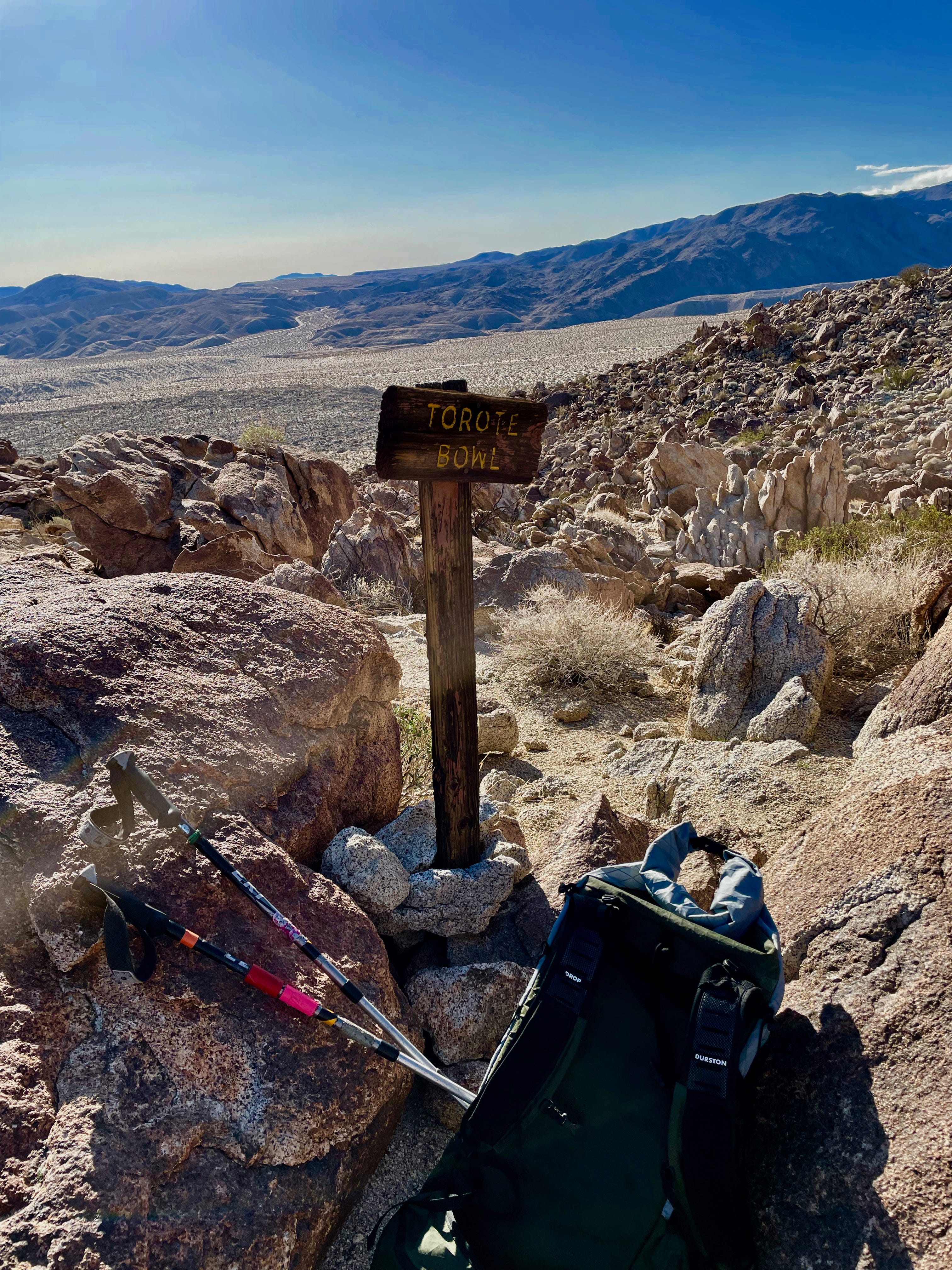
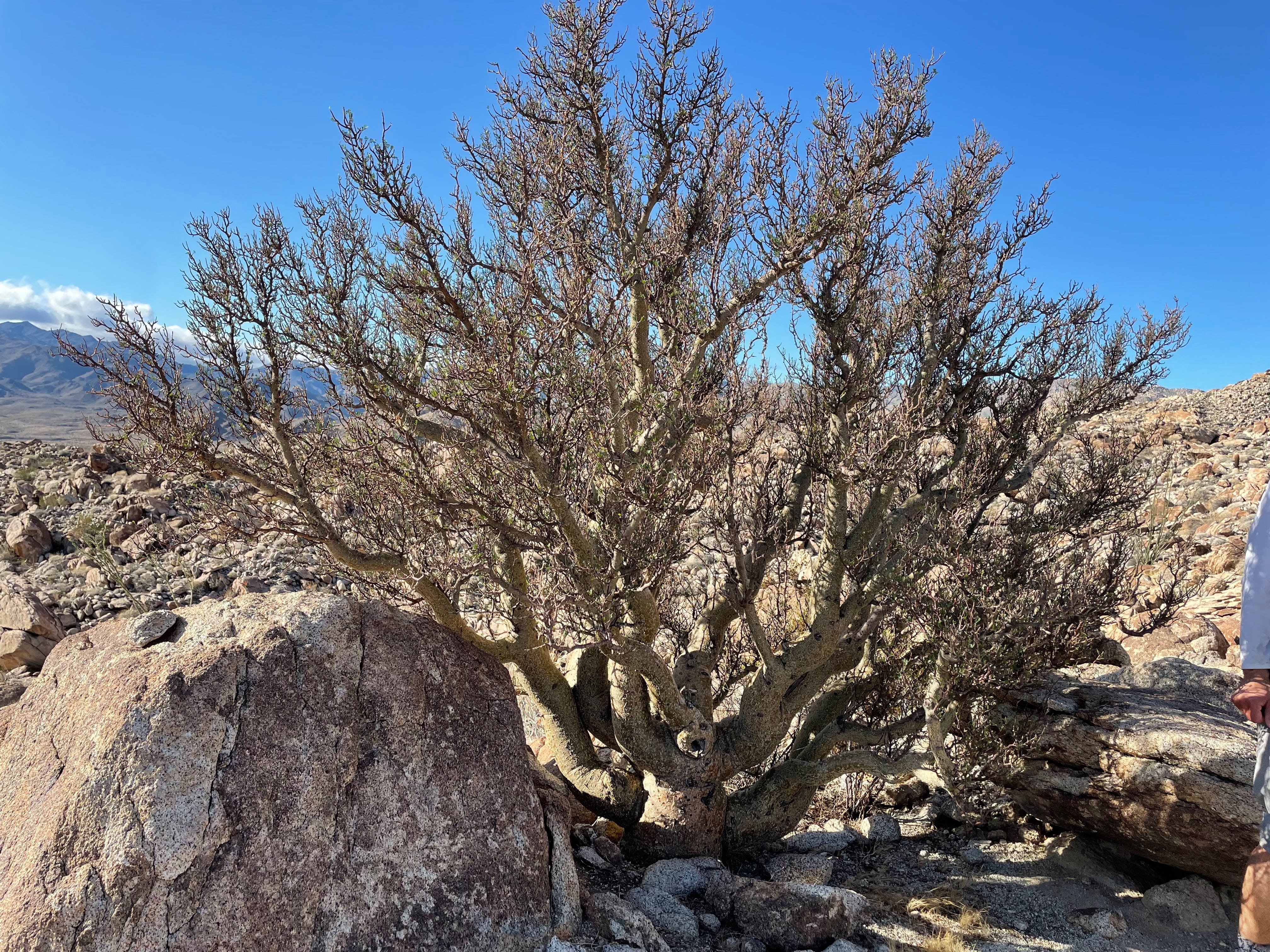
Our caravan descended the well-marked rocky trail to the first fan palm oasis. We had kept an eye out for the shy bighorn sheep known to drink at the lush groves but all we saw along the tea-brown waters were their droppings. Still, it’s always a joy to come upon a fertile spot in the desert. The group would go on to three or four other oases but I had to turn around. Carol led me back to the trailhead where we were gleefully surprised by a sun-bathing snake who did not move for us.
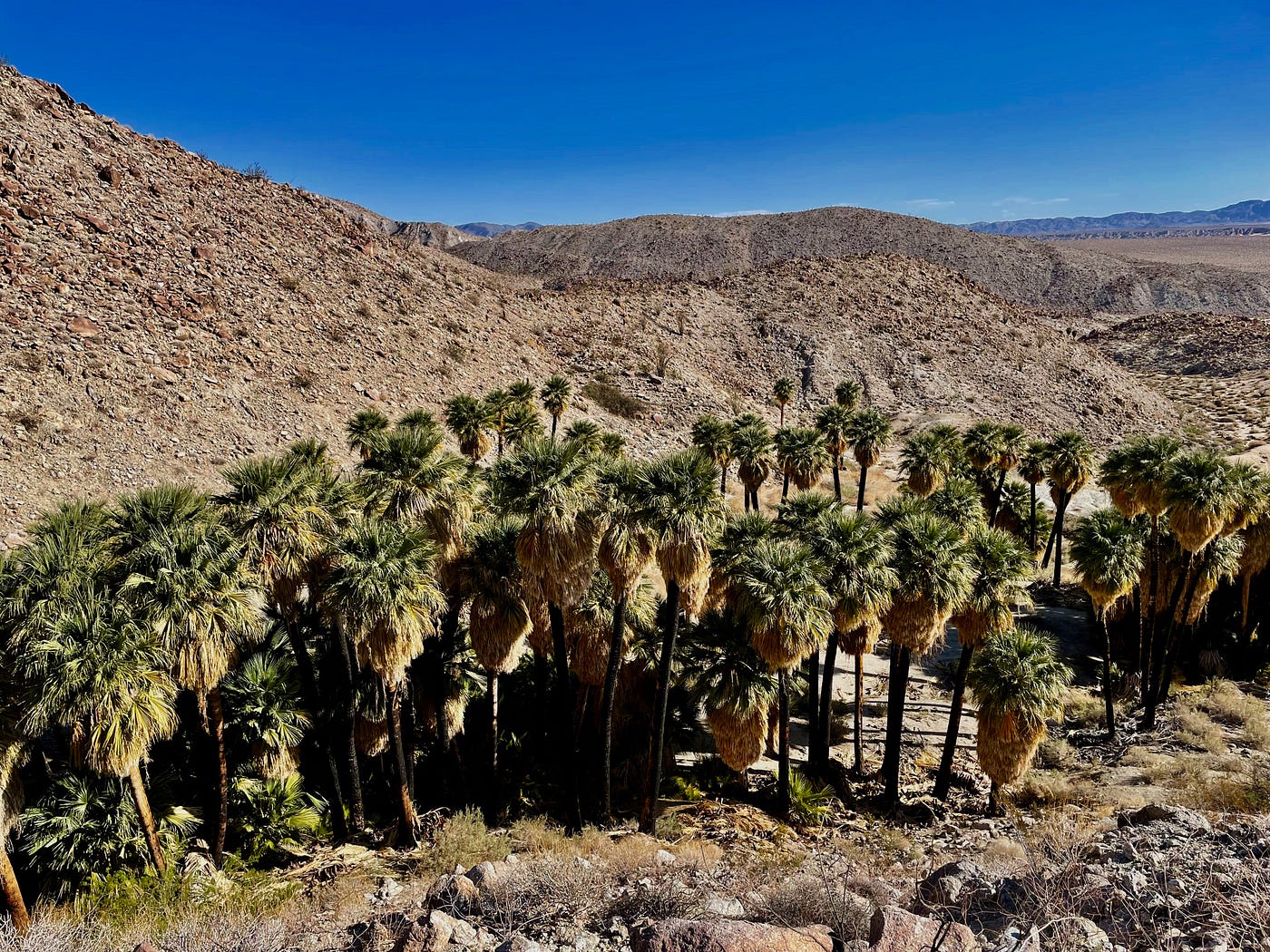
I hated to leave so early and miss the desert’s grand sweep of unfiltered light, the way its daily spectrum keeps transforming every rock, plant, and mountain it touches. Even more, I hated to leave the group—one always bonds with fellow Survivors. I consoled myself that we belong to a fraternal order of desert aficionados. The likelihood of our meeting again is good.

If you like exploring desert wilderness join the Survivors. It costs only $30 a year to belong to Desert Survivors and learn about the trips you might join around the West.



